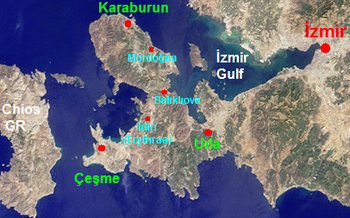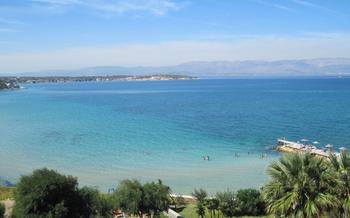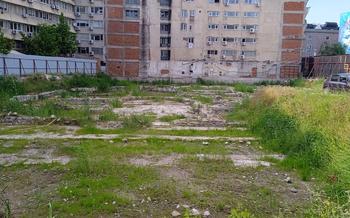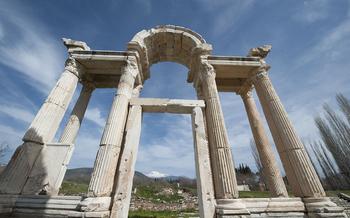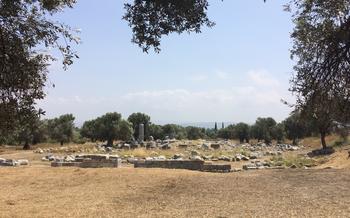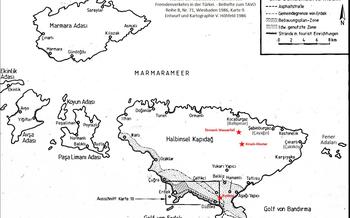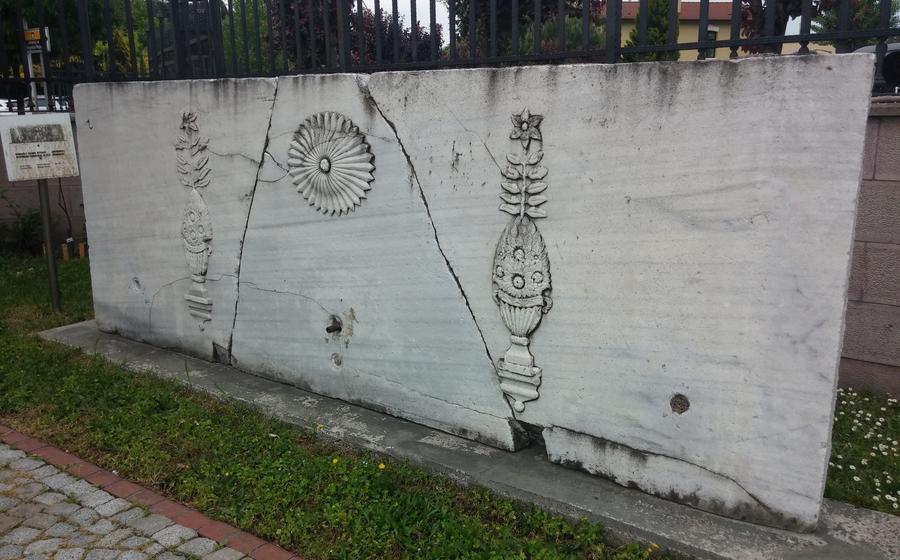
Çeşme Archaeology Museum
- Historical Background
- Location and Accessibility:
- Museum Layout and Exhibits
- Highlights of the Collection
- Temporary Exhibitions
- Educational Programs and Workshops
- Research and Documentation
- Accessibility for Visitors with Disabilities
- Museum Shop and Souvenirs
- Photography and Social Media
- Nearby Attractions and Restaurants
- Seasonal Events and Festivals
- Local Customs and Etiquette
- Insider Tip:
Historical Background
Çeşme, an ancient Ionian city on the western coast of Turkey, boasts a rich historical legacy dating back to the 11th century BC. The Çeşme Archaeology Museum serves as a testament to the city's storied past, housing a diverse collection of artifacts that narrate the fascinating journey of Çeşme through the ages.
The museum's collection takes visitors on an enthralling voyage through time, showcasing the city's role as a prominent member of the Ionian League, a powerful alliance of twelve ancient Greek cities. Çeşme's strategic location at the crossroads of maritime trade routes made it a pivotal center for commerce and cultural exchange, leaving an indelible mark on the region's history.
Over the centuries, Çeşme witnessed the rise and fall of various civilizations, each leaving its unique imprint on the city's identity. From the Greeks to the Romans, and finally to the Ottomans, Çeşme absorbed the influences of diverse cultures, resulting in a captivating tapestry of architectural styles, traditions, and beliefs.
Extensive archaeological excavations conducted in and around Çeşme have unearthed a treasure trove of artifacts that provide invaluable insights into the city's past. These discoveries have enriched the museum's collection, offering visitors a glimpse into the lives, customs, and artistic expressions of ancient Çeşme.
Location and Accessibility:
The Çeşme Archaeology Museum is conveniently located in the heart of Çeşme, just a short walk from the picturesque Çeşme Castle and the vibrant old town. The museum's address is Cumhuriyet Meydanı, 35930 Çeşme/İzmir, Turkey. To reach the museum using public transportation, visitors can take a local bus or dolmuş (shared taxi) to the Çeşme Otogar (bus station) and then walk for approximately 10 minutes. Alternatively, visitors can take a taxi or rent a car to reach the museum directly. The museum is easily accessible by car, with ample parking spaces available in the vicinity. Visitors can also park their cars at the Çeşme Marina and take a leisurely walk along the scenic waterfront to reach the museum.
Museum Layout and Exhibits
The Çeşme Archaeology Museum is organized into several sections or galleries, each showcasing a different aspect of the region's rich history and culture. The museum's layout is designed to take visitors on a chronological journey through time, from the earliest settlements in the area to the Ottoman period.
The main gallery features a collection of artifacts from the Archaic and Classical periods, including sculptures, pottery, jewelry, and coins. Notable exhibits include a statue of Poseidon, the god of the sea, and an amphora with a shipwrecked scene depicting the perils of ancient seafaring.
Another section of the museum is dedicated to the Hellenistic period, with a focus on the city of Erythrai, one of the most important Ionian cities in ancient times. Here, visitors can admire well-preserved mosaics, sculptures, and inscriptions that shed light on the city's vibrant cultural and artistic life.
The museum also houses a collection of artifacts from the Roman and Byzantine periods, including ceramics, glass objects, and architectural elements. These artifacts provide insights into the daily lives and customs of the people who lived in Çeşme during these periods.
Throughout the museum, interactive displays and multimedia presentations enhance the visitor experience by bringing ancient history to life. Visitors can learn about the excavation process, view 3D models of archaeological sites, and even try their hand at deciphering ancient inscriptions.
Highlights of the Collection
The Çeşme Archaeology Museum houses a treasure-trove of artifacts that offer a glimpse into the rich history and cultural heritage of the region. Among the most notable exhibits is the statue of Poseidon, the Greek god of the sea. This majestic sculpture, dating back to the 2nd century AD, stands tall and imposing, showcasing the exquisite craftsmanship of ancient Greek artists. Its intricate details and lifelike features captivate visitors, providing a tangible connection to the ancient world.
Another highlight of the museum's collection is an amphora with a shipwrecked scene. This exquisitely decorated vessel, crafted in the 6th century BC, depicts a dramatic maritime disaster. The intricate details of the shipwreck, including the struggling sailors and the turbulent waves, offer a vivid glimpse into the perils of ancient seafaring. The amphora serves as a poignant reminder of the challenges faced by ancient mariners and the importance of maritime trade in the region.
The museum also boasts a remarkable collection of gold jewelry from the Lydian period (7th-6th century BC). These intricate pieces, crafted with exceptional skill, showcase the artistry and opulence of the ancient Lydian civilization. From delicate necklaces and earrings to elaborate bracelets and rings, each piece tells a story of wealth, power, and craftsmanship. The Lydian gold jewelry offers a fascinating glimpse into the lives and customs of this ancient kingdom.
Temporary Exhibitions
In addition to its impressive permanent collection, the Çeşme Archaeology Museum often hosts temporary exhibitions that showcase specific themes or topics related to Çeşme's rich history and culture. These exhibitions provide visitors with an opportunity to explore new perspectives, delve deeper into certain aspects of the region's past, and appreciate the diversity of artifacts and stories that Çeşme has to offer.
Currently, the museum is hosting a fascinating exhibition entitled "Treasures of the Sea: Shipwrecks and Maritime Trade in Ancient Çeşme." This exhibition showcases a remarkable collection of artifacts recovered from shipwrecks off the coast of Çeşme, providing a glimpse into the vibrant maritime trade and cultural exchange that took place in the region during ancient times.
Visitors can marvel at well-preserved amphorae, bronze statues, and jewelry, each telling a story of long-lost voyages and the interconnectedness of ancient civilizations. The exhibition also features interactive displays that allow visitors to explore the underwater world and learn about the challenges and techniques involved in underwater archaeology.
For those with a passion for history, culture, and maritime exploration, this temporary exhibition is a must-see. It offers a unique perspective on Çeşme's past and enriches the overall museum experience. Be sure to check the museum's website or social media pages for information on upcoming temporary exhibitions and plan your visit accordingly.
Educational Programs and Workshops
The Çeşme Archaeology Museum offers a range of educational programs and workshops to enhance the visitor experience and promote a deeper understanding of ancient Çeşme. These programs are designed for a diverse audience, including school groups, families, and adults with an interest in history and archaeology.
The museum's educational programs cover a wide range of topics related to Çeşme's rich past, such as the history of the Ionian League, the influence of different civilizations, and the archaeological excavations that have shaped our understanding of the region. These programs are led by experienced educators and archaeologists who bring the ancient world to life through interactive presentations, hands-on activities, and storytelling.
Families with children can enjoy the museum's family-friendly workshops, which provide a fun and engaging way for kids to learn about archaeology and history. These workshops often include hands-on activities such as pottery making, coin minting, and artifact identification, allowing children to experience the thrill of discovery firsthand.
The museum also offers guided tours for groups of all sizes. These tours are led by knowledgeable guides who provide in-depth insights into the museum's collection and the history of Çeşme. Guided tours can be customized to suit the interests and needs of the group, ensuring a personalized and enriching experience.
To participate in the museum's educational programs or book a guided tour, visitors are encouraged to contact the museum in advance. The museum's website provides detailed information on the available programs, schedules, and fees.
Research and Documentation
The Çeşme Archaeology Museum is not just a place to showcase artifacts; it is also a center for archaeological research and documentation. The museum collaborates with universities, research institutions, and scholars from around the world to conduct excavations, surveys, and studies in the Çeşme region and beyond.
The museum's collection serves as a valuable resource for researchers studying ancient Anatolian civilizations. The artifacts provide insights into the region's rich history, culture, and daily life. Researchers can access the museum's collection for study and research purposes, contributing to the advancement of our understanding of the ancient world.
If you are a researcher interested in Anatolian archaeology, the Çeşme Archaeology Museum is an excellent place to start. The museum staff is knowledgeable and helpful, and they can provide guidance and assistance to researchers. The museum also offers a library with a collection of books, journals, and research papers related to archaeology and history.
The museum's commitment to research and documentation ensures that the rich cultural heritage of Çeşme and the surrounding region is preserved and shared with the world. Researchers and scholars play a crucial role in expanding our knowledge of the past, and the Çeşme Archaeology Museum is proud to support their work.
Accessibility for Visitors with Disabilities
The Çeşme Archaeology Museum is committed to creating an inclusive and welcoming environment for all visitors, including those with disabilities. The museum features ramps, elevators, and wheelchair-accessible restrooms to ensure that all visitors can easily navigate the premises. Additionally, assistive devices such as audio guides and sign language interpreters are available upon request to enhance the experience for visitors with hearing or visual impairments. The museum staff is always willing to assist visitors with disabilities and provide any necessary accommodations to make their visit as enjoyable and educational as possible. For further information or to request specific accommodations, visitors can contact the museum in advance.
Museum Shop and Souvenirs
The Çeşme Archaeology Museum features a well-stocked museum shop where visitors can purchase a variety of souvenirs and mementos to commemorate their visit. The shop offers a wide range of items, including books, postcards, replicas of ancient artifacts, and other unique souvenirs related to Çeşme's history and archaeology. These items provide an excellent way to remember the museum's collection and share the rich cultural heritage of the region with friends and family back home.
The proceeds from the museum shop play a crucial role in supporting the museum's educational programs and conservation efforts. By purchasing souvenirs from the shop, visitors can directly contribute to the preservation and promotion of Çeşme's cultural heritage. The shop also offers a selection of books and publications that provide in-depth information about the museum's collection and the history of the region, allowing visitors to continue their learning journey beyond their museum visit.
Photography and Social Media
The Çeşme Archaeology Museum welcomes visitors to capture and share their experiences through photography and social media. Visitors are allowed to take photos and videos for personal use inside the museum, except in areas where photography is restricted for conservation or privacy reasons. The museum encourages visitors to share their photos and videos on social media using the hashtag #CesmeArchaeologyMuseum or by tagging the museum's official accounts. By sharing their experiences, visitors contribute to promoting the museum's collection and raising awareness about the rich history of Çeşme. Additionally, the museum's social media platforms offer a glimpse into behind-the-scenes activities, upcoming exhibitions, and educational programs, providing a deeper connection with the museum's community.
Nearby Attractions and Restaurants
After exploring the rich history and artifacts at the Çeşme Archaeology Museum, visitors can venture out and discover other captivating attractions in the vicinity. A stroll through the charming old town of Çeşme reveals a treasure trove of historical sites, traditional shops, and delightful restaurants. Visitors can wander along the picturesque cobblestone streets, admire the Ottoman-era architecture, and soak in the vibrant atmosphere of this ancient town.
For those seeking a breathtaking panorama of the Aegean Sea, the Çeşme Castle stands as a majestic sentinel overlooking the town and the coastline. This 16th-century fortress offers a glimpse into the region's rich military history and provides visitors with stunning views of the surrounding landscape.
Culinary enthusiasts will delight in the diverse dining options available in Çeşme. From traditional Turkish cuisine to international flavors, there is something to satisfy every palate. Visitors can savor the freshest seafood at one of the many fish restaurants along the marina, indulge in delicious Turkish meze and kebabs at a local restaurant in the old town, or enjoy a romantic dinner at a seaside restaurant with panoramic views of the Aegean Sea.
Whether it's exploring the historical streets of the old town, marveling at the grandeur of Çeşme Castle, or indulging in the local culinary delights, there is an abundance of attractions and experiences to be discovered beyond the walls of the Çeşme Archaeology Museum. Visitors are encouraged to venture out and immerse themselves in the vibrant culture and history of this captivating town.
Seasonal Events and Festivals
Çeşme comes alive during the summer months with a vibrant lineup of events and festivals that celebrate its rich history, culture, and archaeology. The Çeşme International Music Festival, held annually in July and August, attracts renowned musicians from around the world for a series of concerts and performances in various venues across the town. History buffs can immerse themselves in the past at the Çeşme Archaeology Festival, which showcases the region's rich cultural heritage through exhibitions, lectures, and guided tours. The festival often features special displays of artifacts from the Çeşme Archaeology Museum, providing visitors with a unique opportunity to learn about ancient Çeşme and its connections to the wider world.
Local Customs and Etiquette
When visiting the Çeşme Archaeology Museum and interacting with the local community, it's essential to be mindful of local customs and etiquette. Dress modestly, covering your shoulders and knees, especially when visiting religious sites or conservative areas. Greetings are essential in Turkish culture; a friendly "Merhaba" (hello) accompanied by a slight nod or handshake is customary when meeting someone for the first time.
Be respectful of local traditions and customs, such as removing your shoes before entering a mosque or refraining from loud noises and disruptive behavior in public places. It's considered polite to ask permission before taking photos of people, especially women. Tipping is not mandatory but is appreciated for services like taxi rides, restaurant meals, and guided tours.
By observing local customs and showing respect for the community, you'll create a positive and enjoyable experience for yourself and those around you. Embrace the opportunity to learn about and immerse yourself in the rich cultural heritage of Çeşme.
Insider Tip:
One of the hidden gems of the Çeşme Archaeology Museum is the "Secret Room", which is not always open to the public. This special room houses a collection of rare and precious artifacts that are not on display in the main galleries. Visitors who are particularly interested in archaeology or history should inquire about the possibility of visiting the secret room during their visit. The museum staff may be able to arrange a special tour or viewing upon request, subject to availability and museum policies. Keep an eye out for special events or guided tours that may include access to the secret room, as these offer a unique opportunity to see some of the museum's most exclusive treasures up close.
